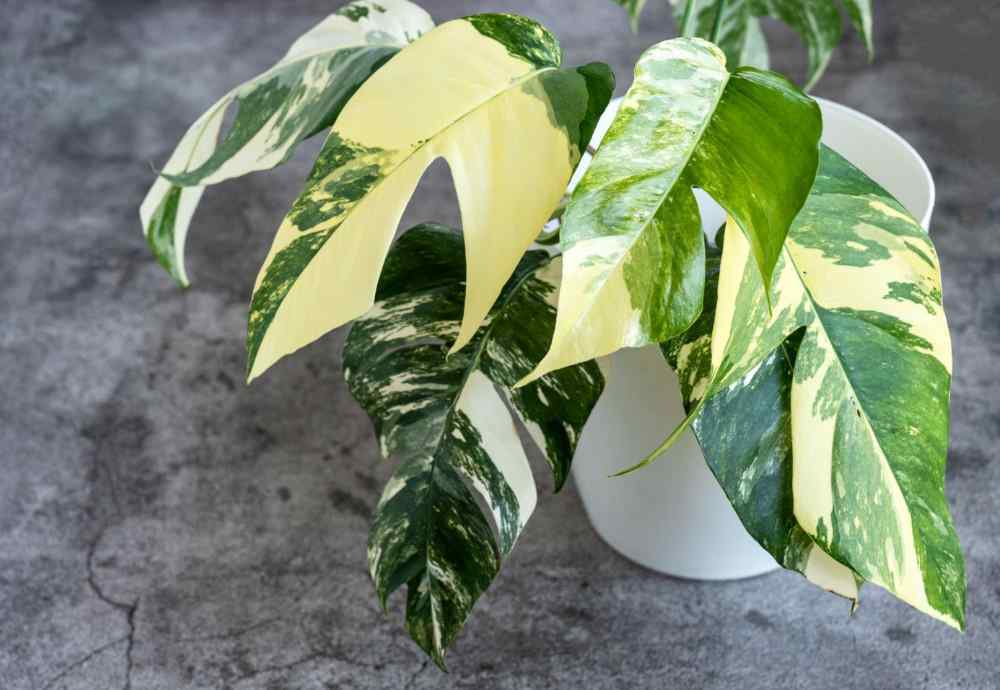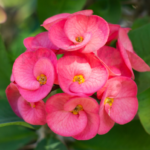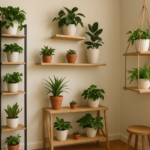Epipremnum Pinnatum Albo, also known as the Variegated Pothos or Devil’s Ivy, A stunning houseplant with mystical properties adds a greenery touch to any space. This tropical vine captivates hearts worldwide with its striking variegated leaves and shades of luscious green and creamy white. But there’s more to this plant than meets the eye; it thrives in low-light conditions and purifies the air, making it an ideal companion for urban dwellers. Let’s explore the fascinating world of Epipremnum Pinnatum Albo and discover its secrets as we discover its remarkable beauty!
What Is Epipremnum Pinnatum Albo?

Epipremnum Pinnatum Albo, also known as Variegated Devil’s Ivy, is a popular houseplant with stunning white and green variegated leaves. This tropical vine is native to Southeast Asia and belongs to the Araceae family. Epipremnum Pinnatum Albo is highly sought after for its unique foliage, which adds a touch of elegance and vibrancy to any indoor space. It is an easy-to-care-for plant that thrives in bright, indirect light and requires minimal watering. With its striking appearance and low-maintenance nature, Epipremnum Pinnatum Albo has become a favorite choice among plant enthusiasts and collectors.
SPECIFICATIONS
Common Name: Epipremnum pinnatum Albo, Dragon-tail plant
Scientific Name: Epipremnum pinnatum ‘Albo’ or Epipremnum pinnatum ‘Albo-Variegata’
Plant Type: Climbing or trailing vine
Leaf Appearance: The leaves have green and white variegation. As the plant matures, the leaves may develop splits or fenestrations.
Light Requirements: Bright, indirect light is best for Epipremnum pinnatum Albo
Soil Requirements: Well-draining
Mature Size: Up to 2.5 feet tall
Where to buy: Try our list of Amazon
Growth Rate: Epipremnum pinnatum Albo can have a moderate to fast growth rate under ideal conditions.
Toxicity: The plant is considered toxic to pets and humans.
Where to buy: Try our list of Amazon
How many types of epipremnum are there?
The plant Epipremnum is sometimes called pothos or Devil’s Ivy, depending on the species or cultivar. Some well-known types are:
Golden Pothos (Epipremnum aureum): Also known as golden pothos or devil’s ivy, it has heart-shaped, variegated leaves with yellow or golden markings.
Dragon’s Tail Pothos (Epipremnum pinnatum): This species has large, elongated leaves with a glossy green color, and some varieties may have variegation.
Marble Queen Pothos (Epipremnum aureum’ Marble Queen’): This pothos is a well-known cultivar of Epipremnum aureum (Epipremnum aureum’ Marble Queen’). It is sought after for its striking variegated foliage.
Neon Pothos (Epipremnum aureum’ Neon’): This cultivar features vibrant neon-green leaves, making it famous for its eye-catching color.
Cebu Blue Pothos (Epipremnum pinnatum’ Cebu Blue’): Blue-green leaves and long, trailing vines distinguish it from other plants. This cultivar is often sought after for its unusual foliage color.
Baltic Blue Pothos (Epipremnum pinnatum’ Baltic Blue’): Like Cebu Blue, Baltic Blue Pothos also showcases blue-green leaves. Plant enthusiasts love it for its attractive foliage.
N’Joy Pothos (Epipremnum aureum ‘N’Joy’): This cultivar exhibits variegated foliage with creamy-white and green patterns. The contrast between the light and dark colors makes it appealing.
Glacier Pothos (Epipremnum aureum’ Glacier’): This cultivar features leaves with white splashes and variegation, resembling icicles or glacier patterns. It adds a unique touch to any indoor space.
Manjula Pothos (Epipremnum aureum’ Manjula’): Manjula Pothos has green, silver, and creamy-white marbled leaves.
Jessenia Pothos (Epipremnum aureum ‘Jessenia’): This cultivar displays leaves with marbled green, cream, and yellow patterns. Its distinct variegation makes it a desirable choice for plant collectors.
Epipremnum pinnatum albo vs monstera albo
Epipremnum pinnatum albo and Monstera albo are popular houseplants that have gained much attention in the gardening community. When comparing Epipremnum pinnatum albo vs Monstera albo, both plants showcase stunning variegated foliage, making them sought after by plant enthusiasts. While Epipremnum pinnatum albo features heart-shaped leaves with creamy white patterns, Monstera albo boasts large, fenestrated leaves with striking white variegation. Each plant has its unique charm and can add a touch of elegance and vibrancy to any indoor space. Whether you prefer the compact growth of Epipremnum pinnatum albo or the dramatic presence of Monstera albo, both plants are sure to captivate and enhance your home decor.
How to Grow and Care for Epipremnum Pinnatum Albo
To grow and care for Epipremnum pinnatum ‘Albo’, also known as the Albo Monstera or Variegated Pinnatum, you can follow these general guidelines:
Sunlight Requirements
Provide bright, indirect light for your Epipremnum pinnatum ‘Albo’. Avoid direct sunlight as it can scorch the leaves. Place the plant near a window with filtered light or in a well-lit room.
What is the best soil for Epipremnum pinnatum albo?
The soil requirements for pinnatum albo variegated are crucial for its well-being. Plants that grow in organic soil with good drainage thrive. The best-growing medium for plants is a mixture of peat moss, perlite, and potting soil. Maintaining the soil’s moisture levels is also essential, as overwatering can lead to root rot. By meeting the specific soil requirements of pothos pinnatum albo, you can ensure that this beautiful plant thrives in your indoor space.
How often to water Epipremnum pinnatum albo?
Epipremnum variegata albo, also known as the Variegated Pothos, is a popular houseplant known for its attractive white and green leaves. When watering this plant, it is important to maintain a balance. You should water your monstera pinnatum albo when the top inch of the soil feels dry to the touch. Underwatering can cause the leaves to wither while overwatering can cause root rot. Water this plant approximately once a week, but always adjust the frequency to suit your specific environment. Use well-draining soil and a pot with drainage holes to prevent waterlogging.
Fertilizing Your Epipremnum pinnatum albo
Fertilizing your epipremnum albo pinnatum is essential for ensuring the optimal growth and health of your plant. You can promote vibrant foliage and encourage robust root development by providing the right nutrients. A fertilizer rich in macronutrients such as nitrogen, phosphorus, and potassium is essential for fertilizing this plant. Feeding your emporium pinnatum albo during the growing season, following the manufacturer’s instructions, will help maintain its vitality and beauty.
Temperature and Humidity
Epipremnum pinnatum ‘Albo’ prefers temperatures between 65°F to 85°F (18°C to 29°C). Protect it from cold drafts or extreme temperature fluctuations. Moderate to high humidity is beneficial for the plant. Consider using a humidifier or placing the pot on a tray filled with water and pebbles to increase humidity levels.
How to propagate epipremnum pinnatum albo?
Epipremnum pinnatum albo, known as the variegated pothos, is a stunning plant with green and white leaves. If you want to propagate this beautiful vine, you’re in luck! Stem cuttings are an easy method for propagating variegated pinnatum albo.
Select a healthy vine and cut a 4-6 inch section below a node. Remove any leaves near the bottom of the cutting and place them in water or a well-draining soil mix. Keep the cutting in a warm and bright location, keeping the soil moist. In a few weeks, you’ll start to see roots forming, and once they are well-established, you can transfer the new plant to a pot with fresh soil. With these easy propagation steps, you can enjoy more of the stunning pothos pinnatum albo in your home.
Repotting & Pruning Epipremnum pinnatum albo
Repotting and pruning are important aspects of caring for Epipremnum pinnatum ‘Albo’. Here are some guidelines for repotting and pruning this plant:
Repotting
- Timing: Repot your Epipremnum pinnatum ‘Albo’ every 1-2 years or when you notice the roots becoming crowded and filling the current pot.
- Choosing a Pot: Select a pot larger than the current one, with good drainage holes at the bottom. Avoid using a large pot, which can keep too much moisture and lead to root rot.
- Preparing the Plant: Water the plant a day or two before repotting to make removing it from the current pot easier. loosen the soil around the root ball, not damaging the roots.
Pruning
- Timing: Prune your Epipremnum pinnatum ‘Albo’ throughout the year as needed. Spring and summer are generally good times for pruning, as the plant is in its active growth phase.
- Reasons for Pruning: Pruning can help control the plant’s size, remove dead or yellowing leaves, and shape the plant to your desired form. It can also encourage fuller growth and remove any leggy or stems.
- Tools: Use clean and sharp pruning shears or scissors to make clean cuts. Sterilize the tools before pruning to cut the risk of introducing diseases.
- Pruning Technique: Identify the stems or leaves you want to prune and cut them back to above a leaf node or where the stem meets the main stem. Avoid removing more than one-third of the plant at a time to prevent stress.
- Considerations: Keep in mind that Epipremnum pinnatum ‘Albo’ can grow quite long trailers. If desired, you can trim these back to maintain a more compact size or propagate them to grow new plants.
Training and Support
As Epipremnum pinnatum ‘Albo’ grows, you can provide support like a moss pole or trellis for the vine to climb. This will help the plant develop its characteristic aerial roots and larger leaves.
Common Leaf Problems of Epipremnum pinnatum albo
Epipremnum pinnatum ‘Albo’ can encounter a few common leaf problems. Here are some issues you may come across and tips to address them:
- Yellowing Leaves: Yellowing leaves in Epipremnum albo can or show overwatering or poor drainage. Ensure the plant is not in waterlogged soil and adjust your watering practices . It’s also possible that prolonged exposure to direct sunlight can cause leaf yellowing, so consider moving the plant to a spot with bright indirect light.
- Brown Leaf Tips: Brown tips on the leaves of pinnatum albo are often a sign of low humidity or underwatering. Increase humidity levels around the plant by misting its foliage or placing a humidifier nearby. Ensure you’re watering the plant and, allowing the top inch of soil to dry between waterings.
- Leaf Curling: There are several factors that can cause leaves to curl, including inadequate watering, low humidity, and extreme temperatures. Check the moisture level of the soil and adjust watering as needed. Increase humidity using a humidifier or placing the plant on a tray with water and pebbles. Maintaining a stable temperature environment within the suitable range for the plant can also help prevent leaf curling.
- Brown Spots or Edges on Leaves: Brown spots or edges on the leaves of epi pinnatum albo may result from low humidity, inconsistent watering, or exposure to cold drafts. Maintain a higher humidity level, provide consistent watering, and avoid placing the plant in areas with cold drafts. Ensure the plant is not exposed to temperatures below its preferred range.
- Leaf Discoloration or Loss of Variegation: If the variegated leaves of Epipremnum albo variegata start to lose their coloration or become more green, it could be due to insufficient light. Increase the plant’s exposure to bright indirect light to enhance and maintain the variegation.
PESTS AND DISEASES
Epipremnum pinnatum ‘Albo,’ like any other plant, can be susceptible to pests and diseases. Here are some potential pests and diseases that may affect it:
Pests
- Mealybugs: These small, white insects with a cotton-like appearance often cluster in the leaf axils and along stems. They suck plant sap, causing stunted growth and yellowing leaves. Remove mealybugs with a cotton swab dipped in rubbing alcohol, or use natural insecticides like neem oil.
- Spider Mites: Spider mites are tiny pests that can create fine webbing on the plant. They suck plant juices, causing yellowing, dryness, and leaf drop. To control spider mites, you can use miticides or insecticidal soaps. Increasing humidity around the plant can also help deter their infestation.
- Scale Insects: Scale insects appear as small, raised bumps on stems and leaves. They feed on plant sap, causing yellowing, wilting, and leaf drop. You can remove scale insects by scrubbing them off with a cotton swab dipped in rubbing alcohol. Insecticides formulated for scale insects can also be effective.
- Aphids: These are small, soft-bodied insects that can cluster on the new growth. Insecticidal soap or a strong spray of water will remove them.
Diseases
- Root Rot: Overwatering causes the roots to become waterlogged and rot. To prevent it, ensure the plant is not sitting in water, and the soil has good drainage.
- Powdery Mildew: This white, powdery substance appears on the leaves. A fungus causes it, and fungicides can treat it.
Benefits of Growing Epipremnum Pinnatum Albo
Growing albo epipremnum comes with a plethora of benefits. This popular houseplant adds beauty to your indoor space and contributes to improved air quality. This plant removes harmful toxins and pollutants from the air by epipremnum pinnatum variegated albo. Additionally, this plant is easy to care for, making it suitable for novice and seasoned gardeners. Its lush green foliage and unique variegation add a touch of elegance to any room. Several studies have shown that Epipremnum pinnatum variegata albo promotes relaxation and reduces stress. With many benefits, growing pinnatum albo variegata is a worthwhile investment for a healthier and pleasing living environment.
Frequently Asked Questions (FAQs)
Is Epipremnum pinnatum albo rare?
There is no doubt that Epipremnum pinnatum albo is a rare species. This cultivar of Epipremnum pinnatum, also known as Variegated Pothos or Variegated Devil’s Ivy, is sought after by plant enthusiasts due to its unique variegated foliage. Its leaves feature a beautiful mix of green and white, making it an appealing houseplant. But, the rarity of Epipremnum pinnatum albo can vary depending on availability, demand, and cultivation practices.
Is Epipremnum albo a pothos?
Yes, Epipremnum albo is a type of pothos. Pothos is a common name given to several species of the Epipremnum genus, including Epipremnum aureum (golden pothos), Epipremnum pinnatum (devil’s ivy), and Epipremnum albo (albo pothos). Variegated leaves with white or cream patches distinguish Epipremnum albo.
What is the common name for Epipremnum pinnatum albo?
The common name for Epipremnum pinnatum ‘Albo’ is Variegated Pothos or Variegated Devil’s Ivy.
What is epipremnum pinnatum albo variegata?
Epipremnum pinnatum albo variegata, also known as the variegated pothos or devil’s ivy, is a popular tropical vine in the Araceae family. Variegated leaves with yellow or white splashes characterize this plant. This particular variety is sought after due to its striking foliage, which can add a touch of color and interest to any indoor or outdoor space. Epipremnum pinnatum albo variegata is easy to care for and can thrive in various light conditions, making it a popular choice for beginner and experienced plant enthusiasts.
Is Epipremnum pinnatum fast-growing?
There is no doubt that Epipremnum pinnatum is a fast-growing plant. It can produce new leaves and extend its vines, making it an ideal choice for individuals looking for a plant that will fill up space and provide a lush green aesthetic in a short period.
What is the difference between Epipremnum and pinnatum?
Epipremnum is a genus of plants that includes various species, while pinnatum refers to one of those species within the Epipremnum genus. Each has its distinct characteristics and growth habits, making them interesting choices for indoor gardening enthusiasts.
Is Epipremnum Pinnatum ‘Albo-Variegata’ Toxic?
Yes, Epipremnum pinnatum ‘Albo-Variegata’ (Variegated Pothos or Variegated Devil’s Ivy) is toxic to humans and pets. There are calcium oxalate crystals in the plant that can cause irritation and discomfort if consumed or inhaled. Keep this plant out of reach of children and pets, and seek medical attention if accidental ingestion or contact occurs. Handling all plants cautiously and washing your hands after handling them is always recommended to avoid any potential issues.
Conclusion
Epipremnum Pinnatum Albo is a beautiful and unique plant that makes a stunning addition to any indoor space. Its striking variegated foliage and easy-care nature have become popular among plant enthusiasts. The plant’s ability to purify the air and its adaptability to different light conditions further add to its appeal. Whether displayed as a hanging plant or potted on a stand, Epipremnum albo is sure to bring a touch of elegance and freshness to any home or office. With proper care and attention, this plant can thrive and continue to be a source of beauty and enjoyment for years.
You may also like Epipremnum Pinnatum Variegata







